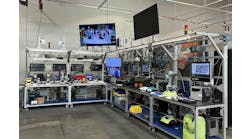In “The Future of Employment,” which was published in 2013, Benedikt Fry and Michael Osborne write about how susceptible jobs are to computerization.
What caught my eye out of the gate was the reference to John Maynard Keynes’s prediction from the 1930s of “unemployment due to our discovery of means of economising the use of labour outrunning the pace at which we can find new uses for labour.” Keynes foresaw this potential outcome more than 80 years ago.
Think of the piston engine replacing the horse and buggy. What ever happened to all of the blacksmiths? The mechanizing of the loom put manual loomers out of work.
The movie “Hidden Figures” tells the story of mathematicians figuring out launch and re-entry algorithms for a spacecraft, manually. These gals were smart.
Enter in a newfangled computer that will calculate the trajectories much faster. The astronauts didn’t trust this new technology and in fact had its star math whiz calculate things manually to confirm the accuracy of the computer.
Trust is a big thing here. Do we trust technology now? You know the answer to that already. We go far beyond trust, which is why cybersecurity is such a hot topic, since we may have found blind faith.
In “The Future of Employment,” the authors refer to 47% of total employment being at risk. Higher-wage jobs with a lower educational “attainment” will be the ones negatively impacted.
We all know that innovation in technology is exponential. We can’t keep up, and, in manufacturing, processes are there for many years, which use legacy technology in today’s terms. Labor was a big part of the solution back then. The risk of removing these higher-wage jobs where cognitive thinking may have a back seat to the physicality on our social fabric is immense. It’s funny how we knew this way back when.
I fully believe that technology is not helping our cognitive selves. How many people can’t add numbers in their heads because they don’t understand the concepts as such? Who knows their own phone numbers anymore? We rely on technology way too much because we trust it and thus use it to its extent, creating a zombie generation.
I speak in general terms of course, but Keynes saw it happening more than 80 years ago. What have we missed?
We have not tended to our knitting over the past 40 years. Our short-term goals and financial greed have put us behind the eight ball. And we have tried to figure out how to get our society out of this mess of declining manufacturing employment and under-employment for years.
The over-employed—high wage with lower cost of entry—are taking the brunt, and we can’t train or retrain them fast enough. I was asked by an individual to help him get trained on PLCs. He has no knowledge, but he is a chemical engineer, which shows he is capable of learning—the definition of a degree in my book. His two PLC guys left for greener pastures, and he was left holding the bag.
Contingency training would have worked here. But take the plight of the McDonald’s cashier who is being phased out by kiosks. Kiosks came first, not the plan for the employees who are lost in the shuffle.
And whose responsibility is it? Well it’s technologies’ responsibility, as funny as that sounds.
Supplanting jobs with technology will continue to happen as it has for years and years. This is nothing new. The speed at which it has happened though is mind-boggling. Technology has allowed global workforces to work in real time, 24/7. Snail Mail Inc. is a thing of the past.
Non-routine tasks are now being impacted by technology; self-driving cars are an example. That’s about as non-routine as it gets. Reactive processes, which we try to program into a control system, take miles of code, but artificial intelligence makes it look easy.
The authors suggest that more than 140 knowledge workers could be replaced by “sophisticated algorithms.” So what are we going to do about it? We know it’s coming.
The authors conclude that non-routine cognitive tasks are ripe for the picking. So how can we use technology to help the displaced individuals become part of the working class after they lose their jobs? More than 700 occupations could be affected.
The displaced will be of varying levels of age, desire, abilities and motivation. The only thing that can deal with this non-routine cognitive problem is technology.
Let’s get busy and prepare somehow, before we melt in a fabric we wouldn’t recognize.






